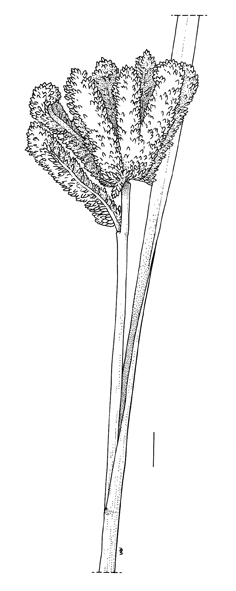1. Eleusine coracana (L.) Gaertn. (syn.: E. indica var. coracana (L.) Ridley, Cynosurus coracanus L.) (Afr.) – A variable species, nowadays usually divided in two more or less characteristic subspecies:
- Seeds faintly granular to nearly smooth, globular. Florets not disarticulating at maturity (crop plant). Stems always erect. Panicle branches very thick, usually incurved at maturity === subsp. coracana
- Seeds distinctly granular, oblong. Florets disarticulating at maturity (weed). Stems often rather decumbent to ascending, rarely erect. Panicle branches more slender and not incurved at maturity === subsp. africana
Subsp. coracana is a minor crop plant (Finger millet, Ragi). In Belgium it is a very rare and always ephemeral alien, possibly introduced as cattle fodder or birdseed. It was observed in a sandy road verge in the port of Gent in 1992 (Verloove & Vandenberghe 1993) and on a dump in Rumbeke-Roeselare in 2004. Formerly also recorded once as a wool alien in the Vesdre valley (1947). Subsp. coracana might be slightly more frequent than usually admitted since plants are often very reluctant to flower in western Europe; they might therefore pass unrecorded. The species is perhaps, at least in some years, a regular component in commercial birdseed mixtures. Non-flowering plants are somehow reminiscent of Echinochloa esculenta and E. frumentacea but have a distinct ligule and remarkably flattened culm bases.
Subsp. africana is much more frequent and now by far the least rare of the genus in Belgium. Up to present it was usually ascribed to Eleusine indica subsp. africana (syn.: E. africana Kennedy-O’Byrne) (see for instance Robbrecht 1983, Meerts 1985). It is distinguished from Eleusine indica s.str. by quantitative characters: rather thick and stiff inflorescence branches, larger glumes and lemmas, etc.
At present subsp. africana primarily is a grain alien. As such it is frequently seen in ports, near unloading quays and grain elevators, by roadsides, at parking lots, as a pavement weed, on dumps, etc. Up to present it remains more or less ephemeral although small populations sometimes persist for some years in urban areas or in ports (for instance as a pavement weed in urban areas in Antwerpen and Gent; also known since at least 2006 from a disused railway track in Zeebrugge). However, at least for the time being and on a global scale, it still is an ephemeral xenophyte in Belgium.
Apart from the characters provided in the key, Eleusine coracana (and E. indica) are furthermore distinguished from E. tristachya by their strongly flattened, keeled lemmas.

Selected literature:
Meerts P. (1985) La flore adventice d’un chantier du métro à Bruxelles. Dumortiera 32: 1-11.
Robbrecht E. (1983) Autosnelwegneofieten, een kategorie van graanadventieven in opkomst? Dumortiera 26: 6-13.
Verloove F. & Vandenberghe C. (1993) Nieuwe en interessante graanadventieven voor de Noordvlaamse en Noordfranse flora, hoofdzakelijk in 1992. Dumortiera 53-54: 35-57.
Wallnöfer B. (2014) Über die Verbreitung von Eleusine indica und E. tristachya (Gramineae) in Österreich. Annalen des Naturhistorischen Museums in Wien, Serie B 116: 181-190.

